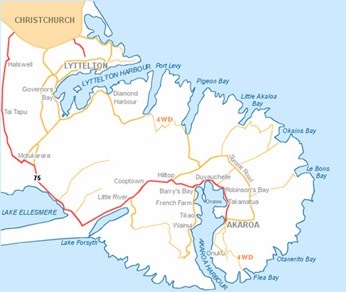Next to the Red Zone is a block-long shopping area where the buildings are all made out of shipping containers.
Shipping containers — Is there anything they can’t do?

I took a tour of the Red Zone today. That’s the part of the downtown area that’s still cordoned off. It’s like touring a war zone or a scene from some post-apocalypse movie where everyone’s vanished. The city and the owners are deciding which buildings can be saved, which have to be destroyed, and how to demolish buildings safely. (A few days ago they found asbestos in one of the bank buildings.) Some buildings have concrete-filled shipping containers in front of them to keep them from falling over.
One problem is liquefaction. The whole area is an alluvial plain. During an earthquake (and during each of the hundreds of aftershocks), liquefied ooze shoots to the surface, causing foundations to shift and generally wreaking havoc. Some buildings that were found to be stable after the main earthquakes had to be demolished after smaller aftershocks made them unsalvageable.
I had to sign an assortment of waivers to take this tour, and they gave us a safety briefing on the bus full of dire warnings, then offered people a chance to leave. As far as I could tell, it wasn’t any more risky than walking around next to damaged buildings outside the Red Zone.
This installation is “intended to generate reflection about the implications of traditional house structures in Western culture,” it says here.
And it has, too. I’ve been reflecting and reflecting.
Spent a few hours in Akaroa, an ostensibly French town in the caldera of an extinct volcano. There was no one there except for me and about 17 billion other tourists.
The setting is stunning. The rim of the volcano forms a harbor of beautiful blue-green water.

In 1838, Captain Jean François L’Anglois bought most of Banks Peninsula from the Māori, then returned to France to find people willing to start a French colony. The British heard about this and, never missing a chance to stick it to the French, claimed the territory and set up a regional government, which the French colonists found waiting for them when they arrived in 1840. They stayed anyway, and Akaroa became a French town with a Māori name in British territory. Today, though, the only noticeable French influence is some of the street names.
My guidebooks all describe Christchurch as “the most British of New Zealand cities.” They show pictures of the downtown area that look like this:
The downtown currently looks more like this:
Parts of it are reconstructed, but it’s a big job and they have a long way to go. Part of the reason may be that the government, like governments everywhere, has Grand Plans. They’re going to put in a stadium and a sports center and a performing arts precinct and a new library and several other things that I’ve forgotten. I’d wager that they don’t have the money to do any of it. So the downtown is still in rubble.
That aside, what the guidebooks don’t tell you is that the rest of the city looks more like Los Angeles than Cambridge. They even have agapanthus everywhere.
The only thing that’s British about it is that they drive on the left. The rest looks pretty American.
The first time through the Christchurch airport, I heard someone paged to go to the chicken desk. Much of the surrounding area consists of farms and ranches, but why they would have a special desk related to poultry was unclear.
When I came back to Christchurch, I heard it again, but now I’m a little more used to Kiwi vowels. It’s the check-in desk.
Which is, incidentally, down the steers and to the lift.